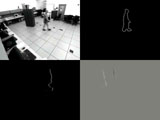Learning Patterns From Video Sequences
Learning Static Occlusions from a Moving Figure
 
In this movie, the upper left quadrant shows a figure moving through an indoor scene. The upper right quadrant shows the perimeter of that figure. Lower left quadrant shows a short term sum of certain perimeter pixels that have been selected as likely to lie on the boundary between the moving figure and an occluding body. Lower right quadrant shows a long term sum of the lower left quadrant, where grey indicates zero, black indicates negative values, and white indicates positive values. Negative and positive values correspond to the left and right edges of the occluding body. (9.8MB)
B. Jackson, R. Bodor, N. Papanikolopoulos, "Learning Static Occlusions from Interactions with Moving Figures",
IEEE/RSJ International Conference on Intelligent Robots and Systems (IROS 2004), pp. 963-968, Sep. 2004.
|
This work is supported by grants from the National Science Foundation, the Minnesota Department of Transportation, the University of Minnesota ITS Institute, and the Department of Homeland Security.
Any opinions, findings, and conclusions or recommendations expressed in this material are those of the author(s) and do not necessarily reflect the views of the National Science Foundation.
|